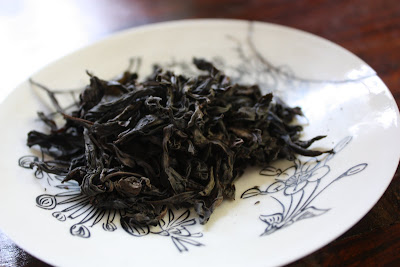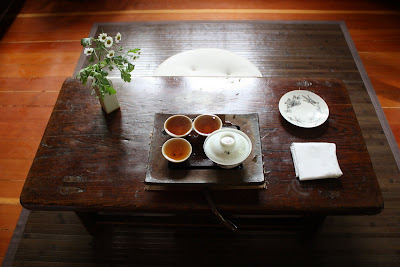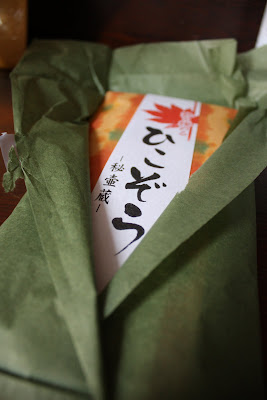
Peace
a blog that is authored by Matt but is yours and the tea's as much as it is his






The seventh, eighth, and ninth infusions become slightly thinner. This space in the cup allows for a wheaty-straw taste to appear. Sweet notes are hidden deep under the cover of dry wood and rarely peep out. This tea really dries you out.
The tenth, eleventh, and twelfth infusions turn watery. Sweet juicy plum notes appear in the initial taste before moving slowly towards a drier, sharper taste and feel. It too melts away slowly in the mouth.

This tea is taken for a handful more longer infusions. It is here where the depth of fruity flavours are realized and appreciated. Only after the gripping dry wood feeling has relented do these tastes become apparent. And so one drinks on for a few days until it becomes too watery.
Peace







After reading the notes provided on the Jagasilk website one is certain that the "slight bitter fruit" in the aftertaste is that of bitter sweet melon notes.
Peace


It didn't take long until one found out why. Jagasilk. This small local company singlehandedly turned Victoria, one of the most traditional colonial tea drinking cities in the West, onto matcha... or should one say "maccha".

Miyuki and Jared Nyberg own and operate Jagasilk. They started out as a matcha and Japanese green tea supplier to local cafes and specialty markets in town and have expanded tremendously since. In the summer of 2009 they opened their own teabar downtown. It is a rather small, cozy, earthy place with a long natural wood tabletop designed by a local artist which acts as the ideal pulpit for which lovers of the leaf can testify their passion for tea of all stripes. There is even a ceramic studio of a famous local Japanese ceramist, Harumi Ota, upstairs. The tea bar is always neither too empty nor to busy- perfect for conversation amongst matcha gulping patrons.

Peace


The name "Fo Shou" literally means "Buddha's Hands" because the shape of the citron can resemble the way images depict the Buddha's hands folded in prayer. Due to its shape the fruit is sometimes offered to Buddha in temples and is thought to be auspicious especially the fruit that looks most like Buddha's folded hands. The fu shou fruit is also used in traditional medicine in Asia where it is dried and sliced into fingers. Interestingly enough this Wuyi oolong not only carries the smells of fu shou fruit but also caries some of its taste and even some of its medicinal properties.
The dry leaves smell like the odour of fu shou fruit- light, airy, long, deep, fresh, starchy citron. Despite the leaves heavy look, they are quite light and fresh smelling. The water boils and, with the company of chrysanthemum flowers, one sits cross-legged on the ground and prepares this tea.
The first infusion emits a sour, malted odour and pours a yellow brown. It tastes light and refreshing with a mild-soapy fruity fo shou and papaya taste. The fruitiness of this tea is distinct right from the start and stretches out on the breath. The aftertaste is sweet with a starchy, sourdough feeling. The mouthfeel is sticky and pasty and is felt inside the lips and on the front of the tongue.
The second infusion is prepared. It reveals tastes with slight roasted notes that are very refreshing. A chalky, slippery papaya-grapefruit-fo shou citrus taste lights up the mouth, it then fades to finish more soapy but with a slight tangy taste. Relatively heavier roasted notes are the last to linger on the breath. The fo shou fruit is said to have flavours that are acidic and sour- this tea definitely shares some of these qualities but in a way that is not at all offensive. The cha qi of this tea feels very neutral, it pulls energy from the extremities and mobilizes it in the stomach. Its energy is stabilizing and harmonious to the midbody. The qi of fo shou is said to have similar actions especially that of harmonizing and strengthening the digestive middle jiao.
The third infusion is prepared and consumed. The initial taste is creamy, soapy and soft. Soon a substantial citrus quality dominates then fades back to creamy and soapy tastes once again. The roasted notes have all but gone. The aftertaste is subtle, creamy and with papaya, fo shou notes. The mouthfeel remains sticky and pasty but not overly thick. This tea is very refreshing although maintaining a very neutral thermal nature.
The fourth infusion has a slight slippery-roasted start, fruit notes have faded slightly and stabilize in the aftertaste. The fruity aftertaste is long. The mouthfeel develops a very soft sandy quality. This tea is refreshing and replenishing. The chaqi is moves throughout the body but is rooted in the digestive center. The movement is felt most in the chest and upper body, its affect is slightly relaxing. Interestingly, the qi of fo shou has some similar actions in the body especially to sooth and relax, to move qi, and to stabilize digestion.

In the fifth infusion more green tastes start to emerge with creamy more melon-citrus tones. The mouthfeel becomes more tight and thin. The aftertaste is lingers and caries this distinct melon-citrus taste for a long while.
The sixth and seventh infusions sees tastes that are still very noticeable but feel more full on the end and in the aftertaste. The initial taste is watery then turns almost woody. The fruity notes have migrated to the aftertaste, although they are still quite noticeable they start to loose weight. The melon-citrus aftertaste is long and enjoyable.

The last few infusions turn extremely watery but still share hints of woody notes as well as different fruity notes to enjoy.
Peace



A long time ago, before the age of nitro flushing, vacuum sealing, or foil packs this was the only way to protect the quality of tea leaves through the warm humid Summer which tended to quickly degrade the tea. So nowadays with all the latest packing technology why do they continue to make these autumnal teas in Japan?
Many tea masters claim that Fall tea simply tastes the best. They claim that it has more depth to its flavour and is more round in the mouth. The mellowing through the summer definitely gives these teas more depth as well as curb the excess of sweeter, lighter, qualities. Energetically these teas also change. They loose the strong rising and falling directional nature and become softer and slower in their movement throughout the body. This is the result of the slow changes they absorbed while buried underground. They become slightly warmer in thermal nature due to the heat they have generated throughout the summer and due to the final heat drying stage that occurs after they are unburied. For these reasons autumnal shincha and even matcha is much nicer on the stomach and is much more suitable for consumption during the Fall and Winter seasons.
In Korea, although they don't have a formal ceremony, they do drink green tea differently in the fall. In the South they sometimes roast their green tea in the Fall before consumption to give it more fire and warmth thereby harmonizing it with the seasonal change. Last year one drank a Korean tea that was picked in the spring and was left to ferment throughout the Summer before being finished with a traditional firing over an iron caldron in the Fall before being packaged. These interesting teas are quite rare in Korea.

Peace
Edit:
One wanted to also mention the role 'earth' plays in the energetic change that takes place with autumnal green teas but forgot to add this idea to the main body of the post.
It is important to note that autumnal/winter green tea is traditionally stored in earthenware pots when it is buried or stored. These pots contain the energies of Earth and Fire within them. Long storage in these containers imparts the energy of the storage vessel- the energy of Earth and Fire. Earth energy is stable, harmonious, and, of course, earthy. The energy of fire is warming. This is yet another subtle influence on autumnal green teas. If the tea is buried in the earth or at least stored underground, the Earth energy that surrounds it will also influence its subtle nature.
Double Peace




Peace

from Cha Sin Jeon- A Chronicle of the Spirit of Tea, a copy of Zhang Poyuan Chalu recorded by Cho Ui, translated in Korean Tea Classics
Those who do not have a copy of Korean Tea Classics do please follow along and participate by referencing a different English translation available here from The Leaf.
This tea classic will be covered one section a week which will go on for 24 weeks. Feel free to jump in with your commentary at anytime.
Peace

The boiling water cools and the first infusion is prepared. It is a soft, creamy with slight earth notes that finish floral on the breath. The mouth feel is very soft and thin.
The second infusion is prepared and it is much of the first with more depth. A fruity pear note emerges which is very slight. It arcs from soft and fruity to more of a floral taste that is left in the aftertaste. Even the lips and throat are covered in this soft, misty, mouthfeel that, although thin, has a presence to it. As the aftertaste continues, the very light fruit notes seem to have more stamina than the floral here.

The fourth infusion is light, creamy, with a fruity aftertaste that is much stronger than in its initial taste. The flavour has hints of pungent character mixed with measures of floral and fruit. The mouthfeel feels full from the lips to the upper throat.

In the seventh and eighth infusions things start thinning into a fruity water with a mouthfeel that is limited to the front of the mouth. Creamy melon, sweet potato, even squash are some of the notes that glimmer from this light watery soup.
The tea is taken a few more infusions that are either too bitter and gritty or watery and tasteless. No matter, there are still very light earthy-pungent-fruity notes in the mix to dwell on.
Peace




The sixth infusion shows mainly floral notes with a soft aftertaste that drags these notes to the back of the throat.
In the last two infusions, the tea noticeably flattens out and develops a rubbery, bland taste. Sometimes a slight flash of slightly sweet earthy notes is apparent.

This concludes the Dao Tea online tasting event. Thanks to Pedro at Dao Tea for making this possible by supplying the tea and covering a large chunk of the shipping and all those who participated.
Link to Adam's (The Sip Tip) Tasting Notes
Link to Bret's (Tea Goober) Tasting Notes
Link to Nate's (Subtle Experince) Tasting Notes
Peace

Any use of tea for medicinal purposes should be done with full consultation with a medical professional. The material on this blog (text and photos) is the intellectual property of the administrator of this blog. If you wish to use any of it, please ask permission. Citations or reference to text from this blog should be done with explicit reference to and/or a link to MattCha's Blog. Peace